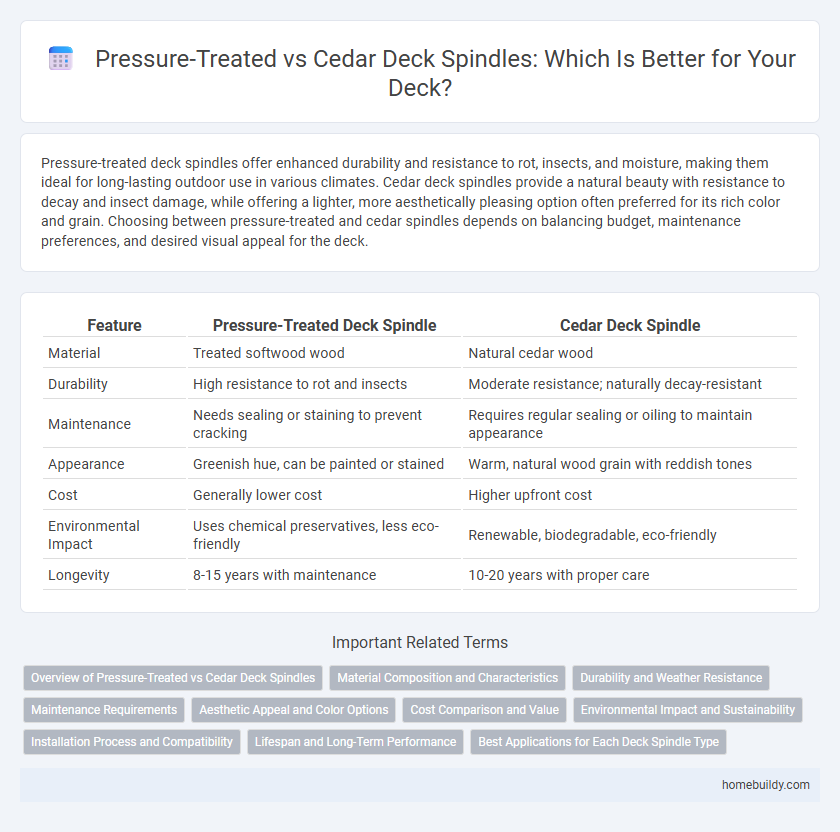Pressure-treated deck spindles offer enhanced durability and resistance to rot, insects, and moisture, making them ideal for long-lasting outdoor use in various climates. Cedar deck spindles provide a natural beauty with resistance to decay and insect damage, while offering a lighter, more aesthetically pleasing option often preferred for its rich color and grain. Choosing between pressure-treated and cedar spindles depends on balancing budget, maintenance preferences, and desired visual appeal for the deck.
Table of Comparison
| Feature | Pressure-Treated Deck Spindle | Cedar Deck Spindle |
|---|---|---|
| Material | Treated softwood wood | Natural cedar wood |
| Durability | High resistance to rot and insects | Moderate resistance; naturally decay-resistant |
| Maintenance | Needs sealing or staining to prevent cracking | Requires regular sealing or oiling to maintain appearance |
| Appearance | Greenish hue, can be painted or stained | Warm, natural wood grain with reddish tones |
| Cost | Generally lower cost | Higher upfront cost |
| Environmental Impact | Uses chemical preservatives, less eco-friendly | Renewable, biodegradable, eco-friendly |
| Longevity | 8-15 years with maintenance | 10-20 years with proper care |
Overview of Pressure-Treated vs Cedar Deck Spindles
Pressure-treated deck spindles are infused with chemical preservatives to resist rot, insects, and weathering, offering enhanced durability and longevity in harsh outdoor environments. Cedar deck spindles naturally contain oils that provide moderate resistance to decay and pests, known for their aesthetic appeal and smooth texture but require more maintenance than pressure-treated wood. Choosing between the two depends on factors such as budget, environmental conditions, and desired lifespan for optimal deck safety and style.
Material Composition and Characteristics
Pressure-treated deck spindles are made from softwood infused with chemical preservatives, enhancing resistance to moisture, rot, and insect damage, making them highly durable for outdoor use. Cedar deck spindles consist of naturally resistant hardwood with essential oils that provide inherent protection against decay and insects, offering a smooth texture and rich color that ages gracefully. Both materials provide structural strength, but pressure-treated spindles prioritize longevity through chemical treatment while cedar emphasizes natural durability and aesthetic appeal.
Durability and Weather Resistance
Pressure-treated deck spindles offer superior durability due to chemical treatments that protect against rot, insects, and moisture, making them ideal for harsh weather conditions. Cedar deck spindles naturally resist decay and insects with inherent oils, providing moderate weather resistance but typically require more maintenance than pressure-treated options. Choosing between the two depends on desired longevity and upkeep, with pressure-treated spindles favored for maximum durability and cedar spindles valued for natural appearance and moderate resilience.
Maintenance Requirements
Pressure-treated deck spindles require minimal maintenance, needing only occasional cleaning and inspection for splinters or damage due to their chemical resistance against rot and insects. Cedar deck spindles demand more frequent maintenance, including regular sealing or staining to protect against moisture and UV damage, which can cause warping or cracking over time. Selecting pressure-treated spindles often reduces long-term upkeep, while cedar promises natural beauty at the cost of increased care.
Aesthetic Appeal and Color Options
Pressure-treated deck spindles offer a uniform greenish hue that can be painted or stained to match various design preferences, though they may require additional finishing for optimal appearance. Cedar deck spindles naturally showcase warm, rich reddish-brown tones with attractive grain patterns, enhancing the overall aesthetic without needing extra treatment. The color options of cedar spindles typically appear more organic and weather gracefully, making them ideal for those seeking natural beauty in outdoor spaces.
Cost Comparison and Value
Pressure-treated deck spindles typically cost less upfront than cedar deck spindles, offering budget-friendly durability through chemical resistance to rot and insects. Cedar deck spindles, while more expensive, provide natural resistance to decay and a more attractive appearance that can increase property value. The long-term value of cedar often offsets the initial cost difference due to its lower maintenance and aesthetic appeal.
Environmental Impact and Sustainability
Pressure-treated deck spindles are chemically infused to resist rot and insects, but the treatment process can introduce harmful preservatives such as arsenic or copper, threatening soil and water quality. Cedar deck spindles offer a more environmentally friendly alternative, as they are naturally resistant to decay without chemical additives and can be sustainably harvested from managed forests. Choosing cedar supports reduced ecological footprint while pressure-treated wood often presents long-term disposal challenges due to toxic chemical leaching.
Installation Process and Compatibility
Pressure-treated deck spindles are heavier and may require pre-drilling during installation to prevent splitting, offering strong resistance to rot and insects for long-term durability. Cedar deck spindles are lighter, easier to handle, and compatible with a wider range of fasteners but need more careful sealing to protect against weathering. Both types can fit standard spindle housings, but pressure-treated wood often demands sturdier support due to its increased weight and moisture content.
Lifespan and Long-Term Performance
Pressure-treated deck spindles typically offer a longer lifespan, often lasting 15 to 20 years due to their resistance to rot, insects, and moisture damage. Cedar deck spindles provide natural durability and aesthetic appeal but generally last around 10 to 15 years, requiring regular maintenance to preserve their integrity. Pressure-treated wood delivers superior long-term performance in harsh environments, while cedar excels in moderate climates with proper care.
Best Applications for Each Deck Spindle Type
Pressure-treated deck spindles excel in environments with high moisture exposure and insect risks, making them ideal for ground-level decks or regions with heavy rainfall. Cedar deck spindles naturally resist decay and offer aesthetic appeal, suited for elevated decks and areas with moderate weather exposure where appearance and scent are valued. Selecting between pressure-treated and cedar spindles depends on balancing durability, maintenance, and visual preference based on specific deck conditions.
pressure-treated deck spindle vs cedar deck spindle Infographic

 homebuildy.com
homebuildy.com